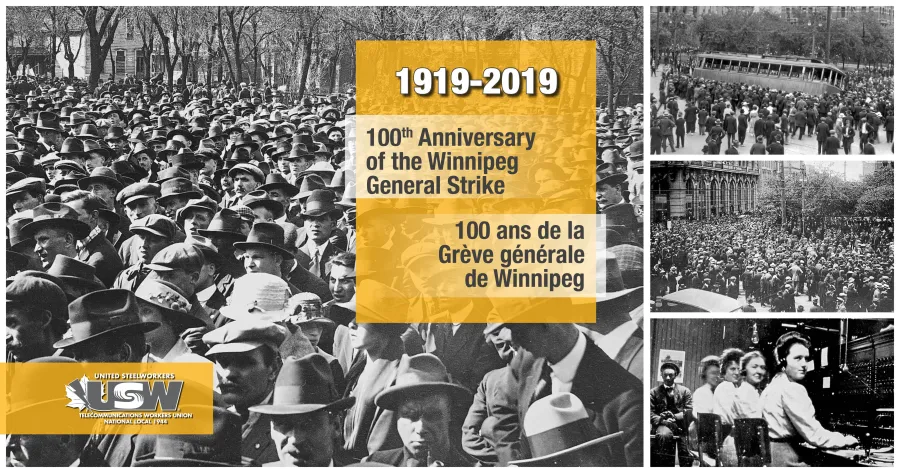The 1919 Winnipeg General Strike: Lessons for our future

As we celebrate the hundredth anniversary of the 1919 Winnipeg General Strike, there are several lessons to be learned from this historic moment of Canada’s labour movement. Much of what workers were fighting for 100 years ago we need to keep fighting for today. With newly elected Conservative governments in Ontario and Alberta, we mustn’t take our rights for granted. Understanding how events unfolded in 1919 can prepare us for securing a better future.
In 1919, workers in Canada were struggling to make a living, suffering inflation, post-war layoffs and extremely unsafe workplaces. With Winnipeg’s building and metal workers on strike for higher wages, on May 6 the Winnipeg Trades and Labour Council polled its membership, composed of more than 70 unions, on their support for a general strike in sympathy with the building and metal workers: more than 11,000 voted in favour, versus 500 opposed.
The Winnipeg General Strike started on May 15, 1919, with female telephone operators refusing to go to work. They were quickly followed by 35,000 workers who left their jobs, shutting down what was then Canada’s third-largest city with a population of 190,000. The strike lasted six weeks, during which it brought together union members with non-unionized workers, public-sector employees joining forces with those in private industry in solidarity.
Corporate and political cynicism bully workers
In 1919, Winnipeg strikers questioned having an economy dominated by unfettered capitalism and a social order that put profit before people. They fought for better wages, better working conditions and the right to collective bargaining. The immediate response from employers was to conspire with government to break the strike. The Mayor of Winnipeg banned parades and dismissed the entire city police force after officers refused to sign a loyalty pledge.
The strike rippled across Canada. At the end of May 1919, postal workers in western Canada went on sympathy strikes. On June 14, when the Vancouver Sun tried to publish an editorial called “No Revolution in Vancouver” the Sun’s printers walked out. The strike demonstrated that it’s ultimately people who create wealth, and can take it away. It unified the labour movement and set the basis of a massive labour reform.
Faced with the combined forces of the government and the employers, the strikers had no choice but to return to work on June 25, four days after the “Bloody Saturday” demonstration, when “specials” armed with guns and clubs charged into a crowd. Strikers were deported and many lost their jobs; two were killed; ten of the strike leaders were arrested and imprisoned, including J.S. Woodsworth, the future founder of the CCF, precursor to the NDP. It took almost three decades for Canadian workers to secure union recognition and collective bargaining.
Today: Unionization rates in the private sector are down, increasing the risk that employers will attempt to replace employees by non-unionized contractors. While corporate profits generate billions, workers’ wages continue to stagnate. CEOs can now earn more in one day than the average worker’s annual salary. When workers are isolated and unorganized, it is easy for companies to squeeze their workforce to obtain minimum wages and maximum profits.
With a changing economic landscape, the key lesson from the strike is that we need to overcome our fears and divisions, to unionize and safeguard our rights. Organized workers are much better positioned to negotiate good working conditions than those who aren’t. When one member gets actively involved in our Local, it makes us all stronger. This is why Local 1944 regularly calls on our members to get involved and to take action: solidarity really is key.
What does our future look like?
One century ago, the strikers laid the foundation for unions and for the labour rights that protect Canadian workers today. With universal healthcare, minimum wages, old age pensions, employment insurance, maternity leave, weekends, health and safety standards, Canadians benefit from the social safety nets that the strikers fought for in 1919.
However, workers cannot afford to be complacent. The world of work is shifting, bringing new challenges. Many hard-working Canadians are paid poverty-wages to generate their employers’ wealth, with an ever-worsening chance of being able to organize in a Union to obtain a better life.
“Only through unionism can we get prepared for the struggles that lie ahead,” said National President Isabelle Miller. “If history has taught us anything, it’s that we have the power to make social change. Wealth can control power, but workers have a way to take charge too, and that’s what the General Strike did: it stopped the economy, and demanded change.”
In Solidarity,
USW Local 1944
